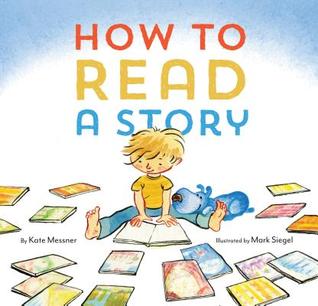By Kate Messner
Illustrated by Mark Siegel
Published 2015
Kate Messner does it yet again!
How to Read a Story is an absolute ‘must-have’ for any teacher’s mentor text library!
It’s an enduring, simple, and delightful story told through the eyes of a child on the most important points to consider when selecting a book to read. Interestingly enough—-the points the child makes are all details and elements that we, as teachers, want students to consider when choosing a story, as well!
So, why not introduce these ideas to your students with a picture book!
How to Read a Story would be a great mentor text for any grade level ‘How-to’ writing unit of study but especially K-2. Messner’s character does an excellent job of presenting steps 1-10 and adding elaboration to detail each step. Again, as it is written through a child’s perspective, the steps and elaboration are all in ‘child speak’ and ones your students can easily relate to.
In addition, How to Read a Story would be a great read-aloud for any teacher who manages her/his literacy block with the Daily 5. How to Read a Story is a great model for things to consider for “Read to Self” or “Read to Someone”.
Book Talk
The story starts immediately with “Step 1” of How to Read a Story. The narrator (the boy who is in the illustrations) addresses the reader and speaks as if having direct conversation with the reader and dispensing his advice (and not necessarily following all rules of grammar, but shows delightful grammatical liberties and writer’s voice).
Some favorite lines:
“STEP 1
FIND A STORY
A good one.
It have have princesses and castles,
if you like that sort of thing,
or witches and trolls.
(As long as they’re not too scary.)”
The story continues in this familiar way: counting the steps of How to Read a Story, adding the advice and elaboration of the narrator.
Another favorite line:
“STEP 2
FIND A READING BUDDY
A good one.
A buddy can be older….
or younger…
or a person your age.
Or many not a person at all.”
GET THIS BOOK! It's perfect for so many uses in your classroom--from simply enjoying it and having your students identify with the choices that the narrator makes--to using it as a mentor text for reading and writing workshop.
I think the format of How to Read a Story can be inspirational for some of your reluctant writers.
Suggested Uses As a Mentor Text:
Book Genre: How-To, Procedural, Narrative Informational
Reading Workshop Strategies: Fluency, Predicting, Questioning
Writing Workshop Strategies: How-To, Procedural Writing, Elaboration/details, Grades K-2, Boy Hook, Inspiring Writers, Strong Ending
Kate Messner’s website :http://www.katemessner.com/

